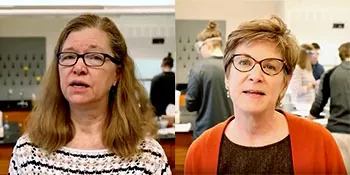Watch: The Chemistry of Art
Last fall, a new interdisciplinary course allowed students to examine the role science plays in the artistic world, from the chemical creation of painters’ pigments to the preservation of those hues in museum masterpieces.
The course, Art, Chemistry, and Conservation, was co-taught by Senior Chemistry Lecturer Ginger Heck and Associate Professor of Art History Patricia Reilly. According to Heck, bridging the two disciplines helped students gain an appreciation for the subject in which they’re less familiar.
“Several of our students are biology or chemistry majors and haven’t taken much in the art department,” she says, “so they get an experience from Patricia about the art history and about ways of looking at art from the art perspective. The art students get to see that science isn’t unreachable or unattainable.”

Senior Chemistry Lecturer Ginger Heck (left) and Associate Professor of Art History Patricia Reilly.
Over the course of the semester, students researched the pigments historically used in paintings, synthesized those pigments from scratch in the chemistry lab, and then created their own art pieces using those hues—or inspired by the techniques studied in the class. The chemical makeup of the colors made for some surprising results: when heated together, for example, yellow sulfur and orangey dichromate combined to make chrome green.
The students also met with conservators from local museums to learn the science behind restoring and preserving works of art. Despite their best efforts, though, some pigments are destined for deterioration, the students learned. One notable example, for instance, is the zinc yellow used in the pointillist masterpiece A Sunday Afternoon on the Island of La Grande Jatte, whose lemony hues have taken on a brown tinge over time.
“I never realized that there was so much that went into painting besides putting paint on a canvas,” says Joe Green ’21, who’s considering a career in art therapy. “There’s so much preparation, so much planning, and it can take years—decades—for someone to finish. Learning about the science behind how we see color made me appreciate a lot of things I see in my everyday life.”
It’s that shift in perspective that makes interdisciplinary teaching so meaningful and rewarding—for the students and the professors, Reilly says.
“For me, in a certain way, there’s really no going back,” she says. “It seems to me that it is the best possible educational experience.”
Read more about the many ways Swarthmoreans live with color thrumming in their lives in the Swarthmore Bulletin.



